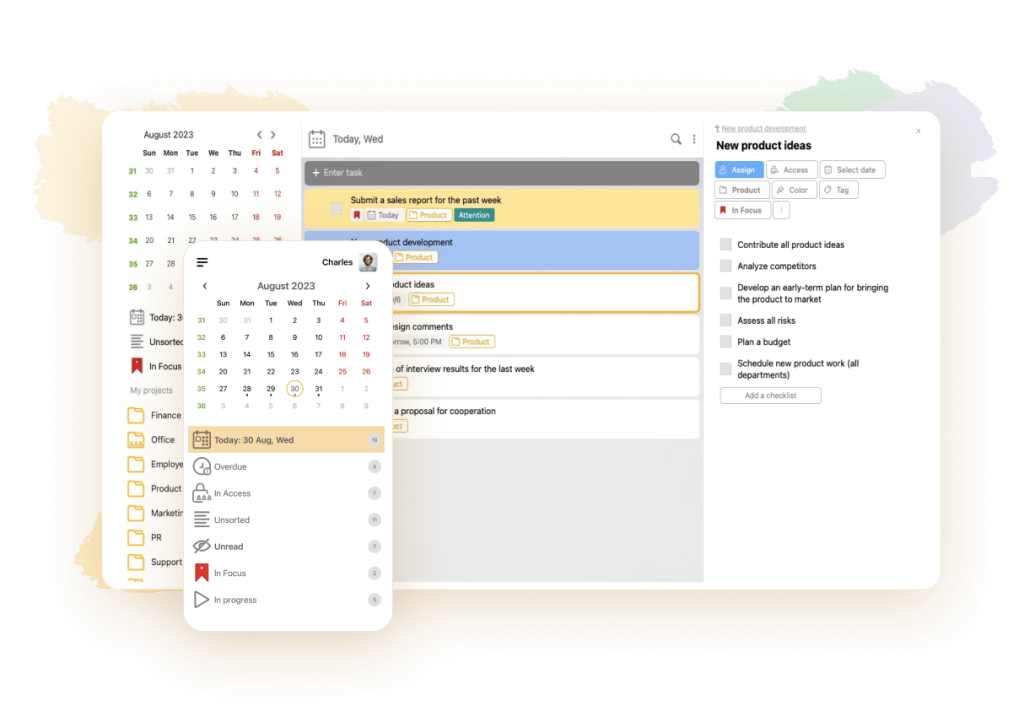The Pareto principle or the 80/20 rule

Trying to keep up with the busy rhythm of modern life, we often try to accomplish a lot of things in a short time. But, often all these efforts do not give the desired result. Why this happens and what to do about it, explains the Pareto law, which is also called the 80/20 rule.
Formulation and operation of Pareto’s law

According to history, the world economy owes the discovery of the law to a talented Italian author, sociologist and economist Vilfredo Pareto. While working in his vegetable garden, the scientist observed pea plantings and noticed that only 20% of planted plants produce the bulk of filled pods. The rest of the specimens produce low quality fruits that do not yield. The law later became famous and was further refined by Joseph Juran, an American researching in quality management, who proved that this rule works effectively in other areas of life as well. For example:
- In the economy. 20% of working people provide for 80% of retirees.
- In commerce. 80% of the profits of trade enterprises come from 20% of customers. 80% of sales come from 20% of products.
- In finance. A 20% investment yields 80% of the return.
- Household. 80% of the clothes a person wears account for 20% of their entire closet.
- Traffic situations. 20% of drivers are responsible for 80% of accidents.
- In employee productivity in enterprises. 80% of the work will correspond to 1/5 of the working hours. 80% of a company’s income is generated by only 1/5 of its employees.
The law applies to work, personal life, science and the economy in general. The 80/20 rule is used to determine the importance of the resources under study and to select priority areas for development. Sometimes these figures change, depending on external circumstances. But, the essence remains the same: most of the results are achieved under the influence of fewer causes.
Principles of the 80 by 20 pattern
The essence of unequal distribution of efforts and resources is realized through the following techniques:
- It is enough to put in a small amount of effort to achieve the intended goal.
- Most of the actions we take in an attempt to implement plans are ineffective.
- The seemingly logical and understandable things and behaviors are not always right.
- Most failures are due to a minimal percentage of unfavorable factors.
- To achieve 80% success, 20% effort is enough. To strive for 100% success is foolish and irrational, as it will take 100% effort.
This pattern can be seen even in relationships between children and adults. Here is a simple example from life: parents want their son to become a musician and put him in a music school. Studying takes a lot of time and effort, most of which is made up of persuasion and conviction in its expediency. The child forcefully agrees to his parents’ conditions, but studies “after a while” in order to get away from it. As a result, the child cannot achieve the desired result.
How effectively the principle works in business and life

The theory of the Pareto Principle 20 by 80 clearly demonstrates how effort affects results. It is applied in business and in ordinary life. It is used when selecting priority areas in activities that require more attention and more careful consideration. Using this approach, you can get rid of unnecessary links in the chain of work processes and unproductive employees who do not benefit the company.
Based on this idea, it is worth deciphering and assuming the hidden factors present in any case. Because of them, it is not always possible to achieve the intended goal. Here is another example: a firm sewing women’s clothing has released feminine and beautiful dresses. But, for some reason, the demand for them is not great. It turns out that the girls who like them, can not afford such styles because of the peculiarities of the figure. And those to whom such outfits will fit, are interested in other models.
If statistical data is analyzed incorrectly, there will be inconsistency and the truth will be distorted. Therefore, it is important to focus only on reliable information in decision making. To determine the 20% of services and goods that will bring profit to the company, it is necessary to perform classification of goods and statistical analysis of past sales.
Application in economics
In the economic sphere, the Pareto efficiency explanation is a state in which the performance of a system cannot be improved without worsening other performance. The ideas are applied in various spheres of business. Their use helps:
- Increase profits and sales in the company;
- Improve staff performance;
- Rationalize the investment in advertising.
The approach works most effectively in management, logistics and marketing.
How to conduct a Pareto audience analysis
In marketing, pareto is used to calculate and, as a consequence, analyze the target audience of online stores. Given that 80% of profits bring 20% of customers, determine the preferences of the main customers. For this purpose, a questionnaire is developed, the content of which contains questions that allow you to learn more about the tastes and interests of users:
- Who are they? (Specify age, gender, place of residence, interests).
- What do people buy at the store? (Main and related products).
- How much is spent on average per visit?
- How did you hear about the store?
Based on the information obtained, optimization is carried out, focus on content and channels that attract loyal customers. They are expanded, promoted and optimized. It is not worth wasting time on an audience that makes purchases from time to time in small quantities.
Assortment analysis
In the course of Pareto analysis of the assortment, a significant 20% of the items that generate most of the company’s profit are identified. They are presented using automated accounting programs or analytical systems. Additional information for analysis is obtained from the following sources:
- social platforms;
- ratings of teaser and banner networks;
- advertising monitoring and viewing services;
- keyword analyzers.
Based on the obtained data, the goods that are in the greatest demand among consumers are selected. They are additionally promoted through advertising channels and the assortment is expanded. Other items for balance should also be present, but in smaller quantities.
Application of the 80/20 principle in human resources management

Pareto’s law states that only 1/5 of workers in companies are productive. The other 4/5 are just “passing the time” at work. The implication is that even in such conditions, the efforts of “progressive specialists” are enough to make the company profitable and efficient.
Does it mean that if you fire 4/5 unproductive employees and hire other professionals in their place, that all of them will work with 100% efficiency? Not at all. Because, according to psychology, any team is inherently passive. That is, the same 20% will remain productive.
To increase the productivity and efficiency of a company’s employees without experiencing an imbalance, you need to:
- Use a quality incentive system;
- introduce time management principles into the company’s organizational structure;
- timely get rid of “ballast” (employees with a negative attitude to work who are not interested in keeping their jobs).
It is possible to make the right decisions in personnel management only after negotiating with everyone and after thoroughly studying the characteristics of employees. Diligent and diligent employees should be singled out, rewarded and given certain preferences. A fair step would be to dismiss the lazy ones and motivate and train the rest of the team.
Where a Pareto chart is used
In time statistics, a Pareto chart is often used to identify the most significant factors affecting the performance of a process. The diagram shows the problems in descending order or frequency of occurrence. This method of analysis consists of and applies to the following situations:
- When there is a need to systematize an increased amount of data;
- To communicate to stakeholders the problems that exist in the company;
- To structure tasks by importance and prioritize them;
- To clarify the relative importance of the data.
The Pareto chart formula is considered along with the benefit-cost analysis. Sometimes the way to eliminate several factors affecting 30% of the problems is more economically feasible than removing a single factor affecting 50% of the problems. In this case, the decision is made based on the economic benefit without considering the place the factor should be in.
How to properly use Pareto’s law to improve performance
Using Pareto principles, you can improve your personal productivity and learn how to highlight the most important things that will bring more results among a huge number of daily tasks. Pay attention to your office colleagues: they spend most of their time on reflection. Distracted by various extraneous matters, social networks, empty conversations, in the end they do not have time to devote to their direct duties. Therefore, they have no time for anything.
In order to get the best results from your work with the least amount of effort, you need to be able to identify the main tasks in the work process. You should spend most of your energy on them. The little things should be put on a distant shelf and work on the rest.
In practice, it looks like this:
- Make broad monthly, weekly and daily to-do lists. Determine which of them are more important and prioritize them. It is convenient to do this with the help of special programs for time planning.
- After calculating the time and energy spent on each task, give them scores on a 10-point scale.
- To find the average between two types of costs add their estimates to each other and divide by 2.
- Also evaluate current and future performance by giving a score from 1 to 10. Based on the data obtained, calculate the average performance.
- Calculate the efficiency of each task by dividing the performance by the average cost.
By categorizing the to-do’s by efficiency, you can select the more important to-do’s. The higher this indicator is, the higher priority is given to this task. It is better to abandon unimportant tasks by delegating them to others or completely refusing to perform them.
Benefits of using the LeaderTask application in time management

Organizing personal and work time management has become much easier with the advent of special programs that help you create schedules, create descriptions, and monitor the execution of plans. These include LeaderTask, which supports all modern time management techniques, including:
- GTD;
- AutoFocus;
- Pomodoro;
- Do It Tomorrow;
- Final Version;
- and others.
LeaderTask will successfully replace the traditional life diary, planner and many other tools used in management. The program is suitable for the following purposes:
- Making to-do lists for the year, month, week or day.
- Combining them into common to-do lists, categorizing them using color selections or labels.
- Project Management.
- Implementing time management principles into the company’s operations.
The app functions on all types of platforms, including iOS, Android, Windows, macOS and Apple Watch.
Results
It is hard to disagree with the fact that the Pareto principle has an impact on all areas of life. If you know and use its rules correctly, you can achieve impressive results. Having identified priority areas, it is worth directing maximum efforts to them. It is better to fully complete one important task than to “almost finish” several minor ones.
We tried to briefly analyze this topic and tell you more about the Pareto principle. Guided by the pareto law, you can increase productivity, make the business more profitable, get rid of unnecessary workload and develop an effective marketing policy for the company. But, at the same time, it is worth taking into account the various associated factors, because of which the method will not work properly.
To make your life and work processes harmonious and organized, it is convenient to use special digital applications for time management. They will help you prioritize your tasks, remind you when they are due, and prevent you from missing any important events, freeing up time for personal business and leisure.



